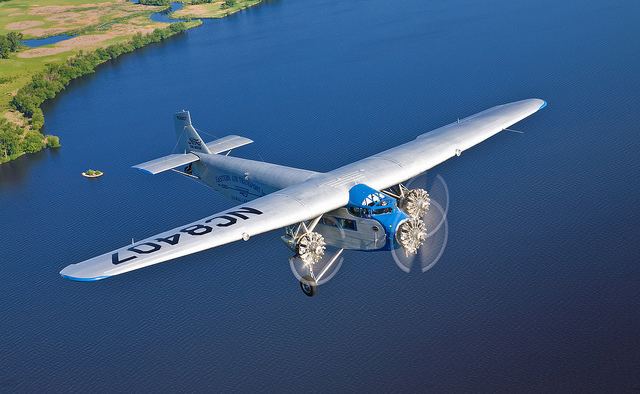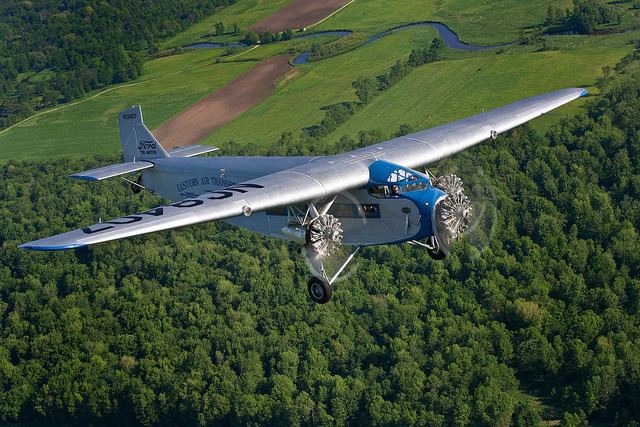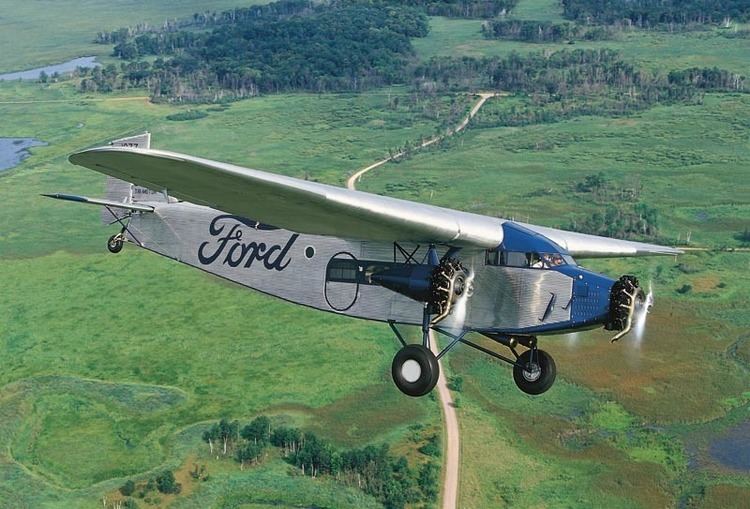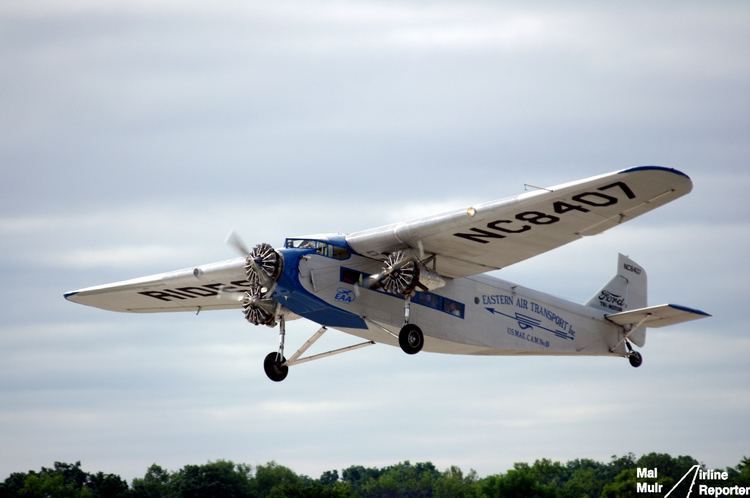Top speed 212 km/h Length 15 m Engine type Radial engine | Wingspan 24 m Introduced 1926 First flight June 11, 1926 | |
 | ||
Unit cost 42,000–42,000 USD (1933), 736,000–736,000 USD (2013) | ||
Giant home built rc ford trimotor super scale airplane
The Ford Trimotor (also called the "Tri-Motor", and nicknamed "The Tin Goose") is an American three-engined transport aircraft. Production started in 1925 by the companies of Henry Ford and ended June 7, 1933. A total of 199 Ford Trimotors were made. It was designed for the civil aviation market, but also saw service with military units. The Ford Trimotor was sold around the world.
Contents
- Giant home built rc ford trimotor super scale airplane
- Design and development
- Operational history
- Variants
- United States military designations
- Civil operators
- Military operators
- Accidents and incidents
- Surviving aircraft
- Airworthy
- On static display
- Under restoration
- Specifications Ford 4 AT E Trimotor
- References

Design and development

The story of the Ford Trimotor began with William Bushnell Stout, an aeronautical engineer who had previously designed several aircraft using principles similar to, and originally devised by Professor Hugo Junkers, the noted German all-metal aircraft design pioneer.

In the early 1920s, Henry Ford, along with a group of 19 other investors including his son Edsel, invested in the Stout Metal Airplane Company. Stout, a bold and imaginative salesman, sent a mimeographed form letter to leading manufacturers, blithely asking for $1,000 and adding: "For your one thousand dollars you will get one definite promise: You will never get your money back." Stout raised $20,000, including $1,000 each from Edsel and Henry Ford.

In 1925, Ford bought Stout and its aircraft designs. The single-engined Stout design was turned into a multi-engined design, the Stout 3-AT with three Curtiss-Wright air-cooled radial engines. After a prototype was built and test-flown with poor results, and a suspicious fire caused the complete destruction of all previous designs, the "4-AT" and "5-AT" emerged.
The Ford Trimotor using all-metal construction was not a revolutionary concept, but it was certainly more advanced than the standard construction techniques of the 1920s. The aircraft resembled the Fokker F.VII Trimotor (except for being all-metal which Henry Ford claimed made it "the safest airliner around"). Its fuselage and wings followed a design pioneered by Junkers during World War I with the Junkers J.I and used postwar in a series of airliners starting with the Junkers F.13 low-wing monoplane of 1920 of which a number were exported to the US, the Junkers K 16 high-wing airliner of 1921, and the Junkers G 24 trimotor of 1924. All of these were constructed of aluminum alloy, which was corrugated for added stiffness, although the resulting drag reduced its overall performance. So similar were the designs that Junkers sued and won when Ford attempted to export an aircraft to Europe. In 1930, Ford countersued in Prague, and despite the possibility of anti-German sentiment, was decisively defeated a second time, with the court finding that Ford had infringed upon Junkers' patents.

Although designed primarily for passenger use, the Trimotor could be easily adapted for hauling cargo, since its seats in the fuselage could be removed. To increase cargo capacity, one unusual feature was the provision of "drop-down" cargo holds below the lower inner wing sections of the 5-AT version.
One 4-AT with Wright J-4 200-hp engines was built for the U.S. Army Air Corps as the C-3, and seven with Wright R-790-3 (235 hp) as C-3As. The latter were upgraded to Wright R-975-1 (J6-9) radials at 300 hp and redesignated C-9. Five 5-ATs were built as C-4s or C-4As.
The original (commercial production) 4-AT had three air-cooled Wright radial engines. It carried a crew of three: a pilot, a copilot, and a stewardess, as well as eight or nine passengers . The later 5-AT had more powerful Pratt & Whitney engines. All models had an aluminum corrugated sheet-metal body and wings. Unlike many aircraft of this era, extending through World War II, its control surfaces (ailerons, elevators, and rudders) were not fabric-covered, but were also made of corrugated metal. As was common for the time, its rudder and elevators were actuated by wires that were strung along the external surface of the aircraft. Engine gauges were also mounted externally, on the engines, to be read by the pilot while looking through the aircraft windshield. Another interesting feature was the use of the hand-operated "Johnny brake."
Like Ford cars and tractors, these Ford aircraft were well-designed, relatively inexpensive, and reliable (for the era). The combination of a metal structure and simple systems led to their reputation for ruggedness. Rudimentary service could be accomplished "in the field" with ground crews able to work on engines using scaffolding and platforms. To fly into otherwise-inaccessible sites, the Ford Trimotor could be fitted with skis or floats.
The rapid development of aircraft at this time (the vastly superior Douglas DC-2 was first conceived in 1932), along with the death of his personal pilot, Harry J. Brooks, on a test flight, led to Henry Ford's losing interest in aviation. While Ford did not make a profit on its aircraft business, Henry Ford's reputation lent credibility to the infant aviation and airline industries, and Ford helped introduce many aspects of the modern aviation infrastructure, including paved runways, passenger terminals, hangars, airmail, and radio navigation.
In the late 1920s, the Ford Aircraft Division was reputedly the "largest manufacturer of commercial airplanes in the world." Alongside the Ford Trimotor, a new single-seat commuter aircraft, the Ford Flivver or "Sky Flivver" had been designed and flown in prototype form, but never entered series production. The Trimotor was not to be Ford's last venture in aircraft production. During World War II, the largest aircraft manufacturing plant in the world was built at the Willow Run, Michigan plant, where Ford produced thousands of B-24 Liberator bombers under license from Consolidated Aircraft.
William Stout left the Metal Airplane division of the Ford Motor Company in 1930. He continued to operate the Stout Engineering Laboratory, producing various aircraft. In 1954, Stout purchased the rights to the Ford Trimotor in an attempt to produce new examples. A new company formed from this effort brought back two modern examples of the trimotor aircraft, renamed the Stout Bushmaster 2000, but even with improvements that had been incorporated, performance was judged inferior to modern designs.
Operational history
A total of 199 Ford Trimotors were built between 1926 and 1933, including 79 of the 4-AT variant, and 116 of the 5-AT variant, plus some experimental craft. Well over 100 airlines of the world flew the Ford Trimotor. From mid-1927, the type was also flown on executive transportation duties by several commercial nonairline operators, including oil and manufacturing companies.
The impact of the Ford Trimotor on commercial aviation was immediate, as the design represented a "quantum leap over other airliners." Within a few months of its introduction, Transcontinental Air Transport was created to provide coast-to-coast operation, capitalizing on the Trimotor's ability to provide reliable and, for the time, comfortable passenger service. While advertised as a transcontinental service, the airline had to rely on rail connections with a deluxe Pullman train that would be based in New York being the first part of the journey. Passengers then met a Trimotor in Port Columbus, Ohio, that would begin a hop across the continent ending at Waynoka, Oklahoma, where another train would take the passengers to Clovis, New Mexico, where the final journey would begin, again on a Trimotor, to end up at the Grand Central Air Terminal in Glendale, a few miles northeast of Los Angeles. This demanding trip would be available only for a year before Transcontinental was merged into a combine with Western Air Service.
Ford Trimotors were also used extensively by Pan American Airways, for its first international scheduled flights from Key West to Havana, Cuba, in 1927. Eventually, Pan American extended service from North America and Cuba into Central and South America in the late 1920s and early 1930s. One of Latin America's earliest airlines, Cubana de Aviación, was the first to use the Ford Trimotor in Latin America, starting in 1930, for its domestic services.
The heyday for Ford's transport was relatively brief, lasting only until 1933, when more modern airliners began to appear. Rather than completely disappearing, the Trimotors gained an enviable reputation for durability with Ford ads in 1929 proclaiming, "No Ford plane has yet worn out in service." First being relegated to second- and third-tier airlines, the Trimotors continued to fly into the 1960s, with numerous examples being converted into cargo transports to further lengthen their careers, and when World War II began, the commercial versions were soon modified for military applications.
Some of the significant flights made by the Ford Trimotor in this period greatly enhanced the reputation of the type for strength and reliability. One example was Ford 4-AT Trimotor serial number 10, built in 1927. It flew in the United States and Mexico under registration number C-1077, and for several years in Canada under registration G-CARC. It had many notable accomplishments; it was flown by Charles Lindbergh and Amelia Earhart, among many others. It made the first commercial flight from the United States to Mexico City, as well as the first commercial flight over the Canadian Rockies. After damage on landing in 1936, it was grounded and remained for decades at Carcross, Yukon. In 1956, the wreck was salvaged and preserved, and in the mid 1980s, Greg Herrick took over C-1077 and began restoring it. As of 2006, C-1077 is in flying condition again, restored to its December 1927 appearance.
Making headlines became a Trimotor trademark. On November 27 and 28, 1929, Commander Richard E. Byrd (navigator), chief pilot Bernt Balchen, and two other crewmen, the copilot and the photographer, made the first flight above the geographic South Pole in a Ford Trimotor that Byrd named the Floyd Bennett. This was one of three aircraft taken on this polar expedition, with the other two being named The Stars and Stripes and The Virginian, replacing the Fokker Trimotors that Byrd previously used.
A Ford Trimotor was used for the flight of Elm Farm Ollie, the first cow to fly in an aircraft and to be milked mid-flight.
Franklin Roosevelt also flew aboard a Ford Trimotor in 1932 during his presidential campaign in one of the first uses of an aircraft in an election, replacing the traditional "whistle stop" train trips.
The short-range capabilities of the Ford Trimotor were exploited in a search for the lost flyers of the Sigizmund Levanevsky trans-polar flight in 1937. Movie stunt flyer Jimmie Mattern flew a specially modified Lockheed Electra along with fellow movie flyer, Garland Lincoln, flying a stripped-down Trimotor donated by the president of Superior Oil Company. With 1,800 gallons of avgas and 450 gallons of oil in the modified cabin, the Trimotor was intended to act as a "tanker" for the expedition. The Electra was able to transfer fuel in the air from the Trimotor, through a hose cast out the 4-AT's door. With the first aerial refueling test successful, the pair of pilots set out for Fairbanks, landing first at Burwash Landing, Yukon Territory, Canada, on August 15, 1937, but the Trimotor ran out of fuel and crashed in inclement weather the following day. The Trimotor was abandoned on the tundra.
One of the major uses of the Trimotor after it was superseded as a passenger aircraft by more modern aircraft like the DC-3, was the carrying of heavy freight to mining operations in jungles and mountains. The Trimotor was employed for decades in this role.
In 1942, during the Battle of Bataan, a Trimotor was used in evacuations. The aircraft would haul 24 people nearly 500 miles a trip, twice daily. The aircraft was eventually strafed and destroyed by Japanese aircraft.
In postwar years, the Ford Trimotors continued in limited service with small, regional air carriers. One of the most famous was the Scenic Airways Ford Trimotor N414H which was used for 65 years as a sightseeing aircraft flying over the Grand Canyon. The aircraft is still in use as of late 2011, mainly for promotional and film work, though one Trimotor operator offers rides. As of October 2016, a Ford Trimotor was still being used by the Experimental Aircraft Association (EAA) to fly passengers on sightseeing tours.
Variants
United States military designations
Civil operators
Military operators
Accidents and incidents
Surviving aircraft
As of 2012, there are 18 Ford Trimotors in existence, eight of which have current FAA airworthiness certificates.
Airworthy
On static display
Under restoration
From 1954 onwards, efforts have been made to produce a modernized version of the Trimotor as the Stout Bushmaster 2000. Saddled with financial, management and marketing problems, only two examples were initially built with a third fuselage never completed.
Specifications (Ford 4-AT-E Trimotor)
Data from Flight International archives
General characteristics
Performance
